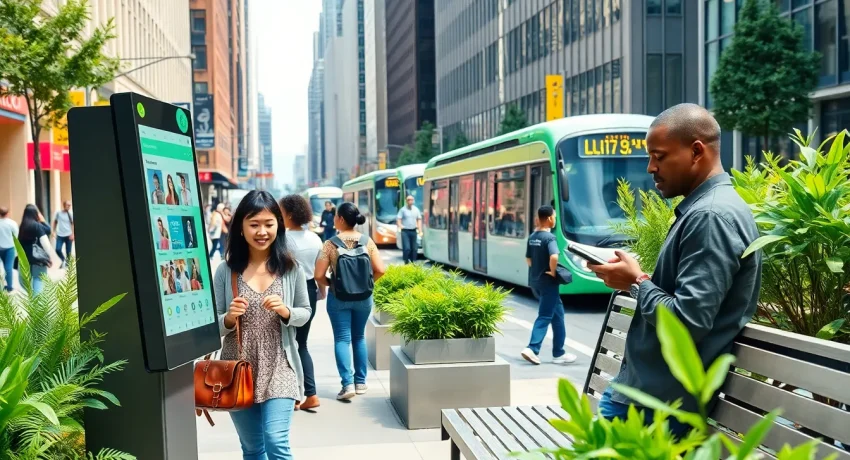Imagine a world where traffic jams are a thing of the past and your fridge knows when you’re out of milk. Welcome to the age of smart city developments, where technology meets urban living in ways that’ll make your head spin—hopefully not while you’re trying to navigate the streets! These innovative cities are more than just a buzzword; they’re a glimpse into a future that promises efficiency, sustainability, and maybe even a robot or two to help carry your groceries.
As cities evolve, they’re embracing cutting-edge technologies to enhance everything from public transport to energy management. It’s not just about shiny gadgets; it’s about creating environments that improve quality of life. Buckle up as we explore how smart city initiatives are reshaping urban landscapes and making life a little more convenient for everyone—because who wouldn’t want a city that thinks ahead?
Table of Contents
ToggleOverview of Smart City Developments
Smart city developments utilize technology to create efficient and sustainable urban environments. These initiatives enhance the quality of life for residents while promoting resource management and innovative solutions.
Definition of Smart Cities
Smart cities integrate digital technology across urban systems to improve services and infrastructure. Data collection, analysis, and connectivity form the foundation for effective city management. Examples include intelligent transportation systems, smart grids, and connected public services. Cities evolve into ecosystems where technology enhances citizen engagement, safety, and mobility. A focus on sustainable practices drives the definition, ensuring that urban growth aligns with environmental goals.
Importance of Smart City Developments
Smart city developments play a crucial role in addressing urban challenges. They alleviate traffic congestion by employing real-time data to optimize transit signals and routes. Sustainability goals receive support through energy-efficient buildings and resource management systems. Economic growth occurs as smart solutions attract businesses and boost local job markets. Improvements in public safety are evident through enhanced surveillance and emergency response systems. Overall, smart city initiatives foster livable communities that balance modern needs with future aspirations.
Key Components of Smart City Developments
Smart city developments comprise advanced technology and innovative solutions to create efficient urban environments. Vital components enhance quality of life and promote sustainability.
Internet of Things (IoT) Integration
IoT integration connects devices and systems, streamlining urban management. Sensors monitor traffic patterns, energy use, and environmental conditions in real-time. Such data enables cities to optimize resources effectively. Connected public services track water usage, waste management, and transportation systems, fostering efficiency. With seamless connectivity, cities enhance residents’ experiences and prepare for future demands. Ultimately, IoT serves as the backbone of smart city frameworks, enabling better decision-making and responsiveness.
Sustainable Urban Infrastructure
Sustainable urban infrastructure focuses on eco-friendly building practices and efficient resource management. This component emphasizes renewable energy sources such as solar and wind. Green buildings utilize sustainable materials and energy-efficient technologies, reducing environmental impact. Moreover, integrated public transportation systems minimize reliance on personal vehicles, decreasing congestion and emissions. Urban green spaces contribute to improved air quality and enhance community well-being. Together, these initiatives form the foundation for resilient and adaptive urban environments.
Innovations Driving Smart City Developments
Smart city developments thrive on cutting-edge innovations that enhance urban living and sustainability. A focus on technology, efficiency, and user experience drives these advancements.
Data Analytics and Big Data
Data analytics plays a crucial role in smart cities by enabling informed decision-making. Cities collect vast amounts of data from sensors, social media, and mobile applications. By analyzing this data, municipal governments can identify trends and optimize public services. Insights derived from traffic patterns improve transportation systems, while real-time monitoring of air quality informs environmental policies. Predictive analytics further helps anticipate issues before they arise, enhancing urban resilience. Investing in data analytics thus transforms raw data into actionable strategies for efficient city management.
Renewable Energy Solutions
Renewable energy solutions form the backbone of sustainable smart city infrastructures. Solar panels and wind turbines generate clean energy, reducing dependence on fossil fuels. Cities integrate smart grids to manage energy distribution effectively. Advanced battery storage systems store excess energy for later use, promoting reliability. Residents benefit from eco-friendly practices, such as energy-efficient buildings and electric vehicle charging stations. Emphasizing renewable sources not only conserves resources but also minimizes carbon footprints, setting a positive example for future urban development.
Challenges in Smart City Developments
Smart city developments face several significant challenges that can hinder their progress. Identifying and addressing these issues is crucial for effective implementation.
Funding and Investment Issues
Securing adequate funding remains a top challenge for smart city projects. Municipal budgets often struggle to accommodate the high costs associated with technology integration and infrastructure upgrades. Public-private partnerships present a viable solution, allowing cities to leverage private sector investment alongside public funding. Innovative financial models, like social impact bonds, also provide new avenues for investment in urban projects. Transparent financial planning can help demonstrate the potential return on investment, attracting more stakeholders.
Privacy and Security Concerns
Privacy and security pose critical obstacles in the rollout of smart city initiatives. As cities implement data collection systems, protecting citizens’ personal information becomes a high priority. Governments must establish clear regulations governing data use to gain public trust. Cybersecurity threats also loom large, potentially compromising essential services. Balancing the benefits of data analytics with robust security measures is vital in addressing these concerns. Engaging communities in discussions about data privacy can enhance transparency and foster collaboration.
Global Examples of Smart City Developments
Various cities globally exemplify smart city developments, showcasing innovation and technology integration. These advancements enhance urban life and promote sustainability in diverse environments.
Notable Smart Cities Worldwide
Barcelona emphasizes smart technology through its intelligent transportation systems and connected public services. Singapore incorporates data analytics in city planning, enabling efficient traffic management and environmental monitoring. Helsinki utilizes an extensive network of sensors to improve public transportation and promote sustainable practices. Amsterdam prioritizes cycling infrastructure while implementing smart lighting and energy-efficient buildings. These cities demonstrate how technology transforms urban settings into smarter, more accessible places.
Impact on Community and Economy
Smart city initiatives significantly benefit local economies by attracting investments and fostering job growth. City populations experience improved quality of life through enhanced public services and green spaces. Residents enjoy reduced traffic congestion thanks to intelligent transportation systems that optimize flow. Eco-friendly innovations contribute to lower energy costs and resource efficiency, boosting local economies. Engaged communities often see increased social cohesion through collaborative platforms that encourage citizen input in urban planning.
Conclusion
Smart city developments represent a transformative shift in urban living. By leveraging technology to enhance efficiency and sustainability, these initiatives address pressing urban challenges while improving residents’ quality of life. The integration of IoT and data analytics is crucial for optimizing resources and fostering community engagement.
However, challenges like funding and privacy concerns must be navigated to ensure successful implementation. As cities around the globe continue to adopt smart technologies, the potential for economic growth and improved public services becomes increasingly evident. The future of urban environments lies in smart city innovations that balance modern needs with sustainable practices, paving the way for resilient communities.





